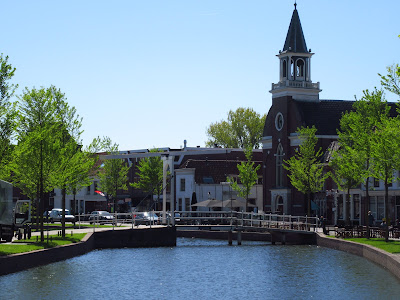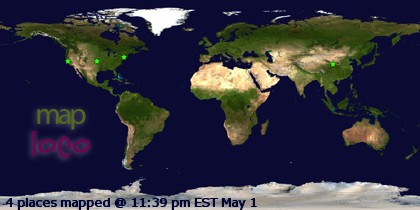One of the things I pre-planned for this trip was doing local bike tours from Amsterdam. I found them on holland-cycling.com, confirmed them on the cycle planning site hollandcyclingroutes.com, and followed them on the bike using the free Fietsknoop app.
I did a bunch of research in advance on finding inexpensive longer term bike rentals; we were planning to rent the bikes and keep them for at least 3 days. In truth, only about 10% of the places you can rent bikes in Amsterdam have an on-line presence. Cheapest of these was Mike's. After a bit of checking, I still think Mike's were a good deal; we paid €46 for two 7 speed bikes for 3 days.
 |
| Our steeds in the shop at pickup |
 |
| Our route |
 |
| A typical path as you head out of Amsterdam |
The Amstel River is fairly big and slow moving, so full of rowers. There are also a few windmills around. Most are "polder mills" the ones built to pump water out of the polder to keep the land dry.
 |
| On the other side |
 |
| On our side |
As we got further south, we left the Amstel River and, as is the case in this area of the Netherlands, crossed canal after canal. We ended up in this little town...
 |
| Note all the bike direction signs |
 |
| The pretty view of the church from the other side |
 |
| Going up |
 |
| Dude a 'crankin' |
 |
| The boat sails through |
 |
| Lady arrives to unlock the bridge |
 |
| The gates are lowered |
 |
| The bridge is up |
 |
| The boat comes through |
 |
| The bridge goes down |
Not much further, at about the 20 km mark, we found our first fort, though there's little of it left.
 |
| It used to be on that island |
Along the way, we crossed the major shipping canal through this section of the country.
 |
| Not a small boat at all |
 |
| A classic Dutch scene |
 |
| The "main drag" |
 |
| Canal houses here |
 |
| Waiting |
 |
| The boat passes |
 |
| You are here |
 |
| Not a bad way to guard your business |
 |
| It's circular |
 |
| Does this photo make it look fat? |
 |
| The plan. Circular fort in the centre |
 |
| Bits of remaining bastion wall |
 |
| The detail |
 |
| Looking our the remains of the bastion walls |
 |
| Seen over the bastions |
 |
| Elegant |
 |
| I swear they're posing |
 |
| An artistic but accidental shot by KC |
 |
| The backside, as we approached |
 |
| The frontside |
 |
| Not a common site |
 |
| Why not, I say. |
 |
| Waiting for the bridge, like everyone else |
 |
| Simple |
On we rode, to the toal highlight of the day: the Muiderslot fortress. At the entrance to a main canal, right on the (then) Zuiderzee, now run by the Rijksmuseum.
 |
| Shades of Monty Python |
 |
| Medieval, alright |
 |
| Nice moat |
 |
| The inner courtyard |
 |
| The sentry walk walls |
 |
| Arrow position details |
 |
| Stairs in a tower |
 |
| Leg irons, anyone? |
 |
| Karen as a damsel |
 |
| Me as a jester |
 |
| Armaments, armour, and all the good stuff |
 |
| From the back side |
 |
| Trellis entryway |
 |
| Center fountain |
 |
| One side flowers, one side veggies |
 |
| Down below is the exhibit |
 |
| Mee shooting on the other side of the water wall |
 |
| The gap is clearly visible |
 |
| 'Aint no gap now |
 |
| Karen shooting my predicament |
 |
| That's me, behind the wall of water |
Alas, it was time to walk around the fort and ride home. Muiderslot's expensive to visit, but well worth it.
 |
| Still Python-esque |
 |
| From the rampart |
 |
| Fun spot |
 |
| Also part of the system |
 |
| They liked round forts |
Aside from Karen crashing and injuring herself, it was a spectacular day for a ride, and having the Muiderslot Castle near the end was a real highlight.
Next up: You can pay €50 to go on a tour to Zaans Schans. We rode there in about 90 minutes, for free.


No comments:
Post a Comment